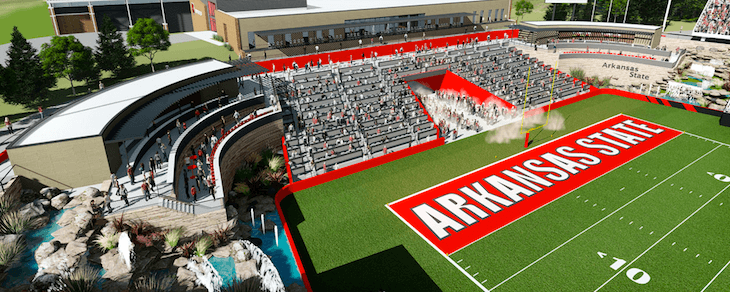Home BancShares Chairman donates $5 million to ASU athletics, Centennial Bank matches the donation
by December 11, 2017 3:53 pm 1,330 views

Home BancShares Chairman John Allison grew up near the field where Arkansas State University plays its football games, and when he went to college, he played on the same bit of ground. Now it’s named for him.
Allison donated $5 million to the ASU athletics department Monday (Dec. 11), and a bank he helped found, Centennial Bank, committed an additional $5 million. Four of the five largest donations in the school’s history have come from Allison and Centennial Bank, ASU System President Chuck Welch said. Centennial’s donation ensures the stadium will continue to use its name until Dec. 31, 2037. Conway-based Home BancShares is the parent company of Centennial.
The money will be used to complete a remodel of the north end zone, a project Athletics Director Terry Mohajir has been working for years to complete. Mohajir met with Allison several times to encourage him to make the donation. ASU-Jonesboro Chancellor Kelly Damphousse said he was amazed by Mohajir’s efforts.
“We would not be here today without his dogged determination … he is the best athletics director in America,” he said.
The money will be funneled through the Red Wolves Foundation, a non-profit group. The donations will ensure that no public money is used to complete the $29 million renovation. Once the project is complete, the new features will enhance the fan experience at the stadium, and the new athletics facilities will help the 350 athletes in ASU’s sports programs, he said. Mohajir, a former ASU player, said naming the field after Allison was an honor he deserved.
“I’ve broken bones on that field. … I’ve bled on that field,” he said.
ADD A DOLLAR TO THE DONATION
Allison credited Mohajir’s aggressive pursuit for the donations. He came to Allison’s office one day to talk about a donation even after the football team began that season 0-4. Mohajir promised the team would win out, and they did, Allison said. At one point during his remarks, Allison realized his family’s donation was only tied for the largest ever given to the school.
“I asked my wife on the way up here if she had any money, and she said $1,” he said to a chorus of laughter. “So, this is a $5 million and $1 donation today.”
An operations building, new locker rooms, position meeting rooms, weight training and rehabilitation areas, hydro-therapy room, and office spaces are part of the project. It will have multiple, unique water features.
The renovation is Mohajir’s vision. It was one of his main objectives when he was hired in 2012. Officials hope the stadium renovations will be completed before the 2018 season begins, and the rest of the project should be finished in early 2019. School officials believe renovations will allow the university to recruit the best athletes in this part of the country, and it should create a better home field advantage for ASU.
The stadium seats more than 30,000 fans. The renovation will reduce the end zone bleacher capacity from a couple of thousand to about 600, but the overall capacity shouldn’t drop below 30,000, he said. Stadium box seats, an all-you-can eat food and drink area, a water feature, and two alcoholic beverage bars are among the planned additions. Luxury boxes, known as the Red Wolves Den, and naming rights opportunities are already being offered. Those naming rights will be in the new expansion. Boxes in the Red Wolves Den section will seat four and private restrooms will be made available.
ASU will relocate its outdoor football practice fields and will construct a Tailgate Promenade. The promenade will include numbered individual parking spots and a connected 10 x 10 tailgate tent intended to create a unique tailgating environment. It will feature private restrooms and allow for personal 10 x 10 tailgate tents for game days.
Construction on the stadium renovation is expected to be completed by the start of the 2018 football season. Facilities construction could extend beyond that depending on the weather and other factors.
FACILITY HISTORY
ASU, then playing with the Indians mascot, played the first game at what would become Centennial Bank Field in September 1974.
The grass field was replaced in 2006 with an artificial playing surface, and in 2010 that turf was replaced with a “GEO Surfaces” field turf.
A three-story complex was built in the south end zone in 2002, which followed a stadium expansion in 1991 that raised the seating from 16,343 to 30,406. The stadium’s multi-level press box includes media areas, coaching booths, broadcasting locations, a video control booth, camera areas, suites, and a club area.
Allison previously donated $5 million – the largest individual donation in ASU Athletics history – for the “Centennial Expansion” construction and renovation project to the stadium’s press box and west-side concourse that took place two years ago. The entire project, including the press box and concourse, covered 40,000 square feet. The
Centennial Expansion project included a complete overhaul to the stadium press box, expanding it from 7,120 to 36,000 square feet. The face of the stadium has been redesigned to include 42 loge boxes, 20 suites, a club area covering close to 8,000 square feet and 344 club seats in its revenue-generating areas.
Centennial Bank has a combined 156 bank offices in Alabama, Arkansas, Florida and New York, according to the Federal Deposit Insurance Corp. The bank’s assets total around $14 billion, Allison said. During the last year, the bank has grown its asset base in Northeast Arkansas by $110 million, he said.
